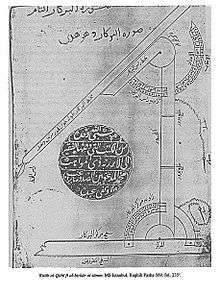Ibn Muʿādh al-Jayyānī
| Al-Jayyānī | |
|---|---|
| Born |
989 Cordova, Al-Andalus |
| Died |
1079 Jaén, Al-Andalus |
| Residence | Caliphate |
| Academic background | |
| Influences | Euclid, al-Khwarizmi |
| Academic work | |
| Era | Islamic Golden Age |
| Main interests | Mathematics, Astronomy |
| Influenced | Alfonso X |
Abū ʿAbd Allāh Muḥammad ibn Muʿādh al-Jayyānī[1] (989, Cordova, Al-Andalus – 1079, Jaén, Al-Andalus) was a mathematician, Islamic scholar, and Qadi from Al-Andalus (in present-day Spain).[2] Al-Jayyānī wrote important commentaries on Euclid's Elements and he wrote the first known treatise on spherical trigonometry as a discipline independent from astronomy.
Life
Little is known about his life. Confusion exists over the identity of al-Jayyānī of the same name mentioned by ibn Bashkuwal (died 1183), Qur'anic scholar, Arabic Philologist, and expert in inheritance laws (farāʾiḍī). It is unknown whether they are the same person.[3]
The book of unknown arcs of a sphere
Al-Jayyānī wrote The book of unknown arcs of a sphere, which is considered "the first treatise on spherical trigonometry",[4] although spherical trigonometry in its ancient Hellenistic form was dealt with by earlier mathematicians such as Menelaus of Alexandria, who developed Menelaus' theorem to deal with spherical problems.[5] However, E. S. Kennedy points out that while it was possible in pre-Islamic mathematics to compute the magnitudes of a spherical figure, in principle, by use of the table of chords and Menelaus' theorem, the application of the theorem to spherical problems was very difficult in practice.[6] Al-Jayyānī's work on spherical trigonometry "contains formulae for right-handed triangles, the general law of sines, and the solution of a spherical triangle by means of the polar triangle." This treatise later had a "strong influence on European mathematics", and his "definition of ratios as numbers" and "method of solving a spherical triangle when all sides are unknown" are likely to have influenced Regiomontanus.[4]
See also
Notes
- ↑ Latin forms include Abenmoat, Abumadh, Abhomadh, or Abumaad, corresponding to either Ibn Muʿādh or Abū ... Muʿādh.
- ↑ Calvo 2007.
- ↑ Dold-Samplonius & Hermelink 1970.
- 1 2 O'Connor, John J.; Robertson, Edmund F., "Abu Abd Allah Muhammad ibn Muadh Al-Jayyani", MacTutor History of Mathematics archive, University of St Andrews.
- ↑ O'Connor, John J.; Robertson, Edmund F., "Menelaus of Alexandria", MacTutor History of Mathematics archive, University of St Andrews. "Book 3 deals with spherical trigonometry and includes Menelaus's theorem."
- ↑ Kennedy, E. S. (1969), "The History of Trigonometry", 31st Yearbook, National Council of Teachers of Mathematics, Washington, D.C.: 337 (cf. Haq, Syed Nomanul, The Indian and Persian background, p. 68, in Seyyed Hossein Nasr, Oliver Leaman (1996), History of Islamic Philosophy, Routledge, pp. 52–70, ISBN 0-415-13159-6)
References
- Calvo, Emilia (2007). "Ibn Muʿādh: Abū ʿAbd Allāh Muḥammad ibn Muʿādh al‐Jayyānī". In Thomas Hockey; et al. The Biographical Encyclopedia of Astronomers. New York: Springer. pp. 562–3. ISBN 978-0-387-31022-0. (PDF version)
- O'Connor, John J.; Robertson, Edmund F., "Abu Abd Allah Muhammad ibn Muadh Al-Jayyani", MacTutor History of Mathematics archive, University of St Andrews.
- Dold-Samplonius, Yvonne; Hermelink, Heinrich (1970). "Al-Jayyānī, Abū'Abd Allāh Muḥammad Ibn Mu'ādh". Complete Dictionary of Scientific Biography. Encyclopedia.com.
